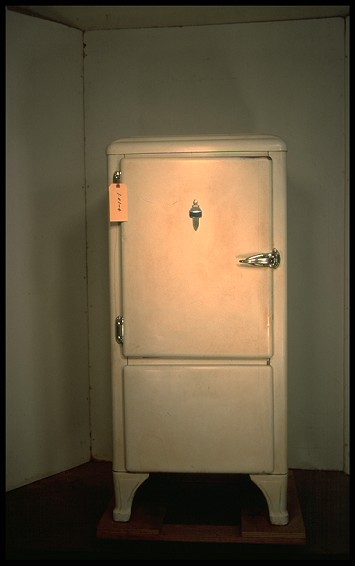Unitary Refrig and A/C Equipment and Systems – Household Cabinet Refrigerators
Technical Significance:
Unitary Refrigeration Equipment: The idea of a unitary piece of refrigeration or air conditioning equipment was a significant one in its own right, one that had to wait its time. The scientists, engineers and inventors in the early years of the 20th century were intrigued and obsessed with the power of the technology and of its possible market potential. What they saw was the newly discovered principles of physics and heat engines – following, for example, the early works of Carnot, Faraday, Kelvin, and the later work of Perkins, Larsen and Carrier, to name a few. They understood the promise of the technology for the public good, not to say its consumer sales potential. Early engineering work advanced on a multiple fronts with development of compressors, heat exchangers, valves and piping variously strung together in configurations that would be found to work, but only after much experimentation.
The arrival of unitary equipment, all those parts organised into a single whole, a single unit of construction, a “black box”, that could be offered to the consumer market was a significant technological and cultural event. Technologically the refrigerator would need to be seen to be safe, reliable, maintainable and useful. As well, in order to attract the development capital needed, it must be seen as potentially saleable and affordable, contributing to life’s needs and desires. Its socio- cultural and economic significance was marked, for it would change much. As Canadians we would quickly come enjoy potentially healthier lives, expect new levels of comfort and convenience, with a broader, safer, more diverse and enjoyable diet.
Canadians would quickly come to think of their day differently, for the day would be defined and punctuated in different ways than ever before, as a result of the introduction of modern, electric, household appliances, of which refrigerators, freezers and room air conditioners would be a central part, by the mid 20th century
J. M Larsen produced a manually operated household refrigerator of sorts in 1913, but it was not until 1918 that the Kelvinator Company marketed the first automatic, unitary refrigerator for the home. In that year, it is reported to have sold sixty-seven machines. (See Note 1) The historic artifacts in Group 1.00, Unitary Equipment, including significant samplings the early work of Kelvinator of Canada, provide a rare view of the evolution of unitary refrigeration and air conditioning applications, as they evolved in Canada in the first half of the 20th century.
For those formative years, the artifacts in this Group, 1.00, are typical of the offerings of the Canadian refrigeration and air conditioning industry. They personified the applications found in the homes, farms and commercial premises of the period for, those that could afford life’s new amenities of comfort, convenience and privilege.
This Specimen: This machine symbolises a unique period in the development of the industry. It was part of the first growth period of the household refrigerator as a mass consumer good, moving beyond the embryonic years and the exclusive appeal to the elite market – once believed to be the only market. A second significant growth period would follow the pent up consumer demand of the late 1940’s a consequence of the Second World War. At that time, it was a first-time buyer’s market without trade-ins to be contended with. But for now the industry was targeting the first time buyer of modest means. It was a “refrigerator in every kitchen marketing” – following the lead of ther auto industry.
Industrial Significance:
By the early 1930’s it was realized that the much hoped for growth period of the industry, like that of the automobile industry, would come not from the manufacture and sale of high-end products, but also through the production of much more popularly affordable machines for middle class consumption, ones configured much better for the kitchens of the nation. – This refrigerator represents the early 1930’s market response to “the refrigerator in every kitchen” movement, paralleling the “automobile in every garage” movement of the times. It was originally priced at a low of $216.00 (See Ref. 1.2, Section 2, Form, C4916AA, price list dated Feb. 1 1935), for a replacement price in 1996 dollars of $2,650 – yet still a very sizeable investment for most households.


